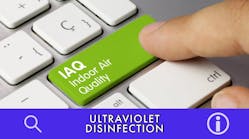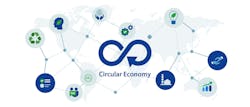ONLINE EXCLUSIVE: Revised EU regulations light the way to more stringent requirements for light sources
Since Thomas Edison invented the first light bulb in 1847, lighting technologies have experienced a fundamental shift from conventional incandescent lamps to modern and more efficient LED technologies. While their first applications were practical electronic components, the spectrum has expanded to include general illumination purposes. In the European Union (EU), new Ecodesign Directive and Energy Labelling Regulation changes take these technological advances into account. They provide consumers with an updated energy efficiency classification system and oblige manufacturers to provide relevant product parameters. The two revised regulations will enter into force simultaneously in the coming year 2021 and are designed to address all light sources, regardless of their underlying technology, be it light-emitting diodes (LEDs and organic LEDs, or OLEDs), fluorescent tubes, or halogen lights.
Increased ecological influence on policy
Introduced roughly ten years ago, Regulation (EC) No. 244/2009 phased out incandescent lamps, while Regulation (EC) No. 245/2009 addressed energy standards in office lighting. Both were aimed at reducing energy and resource consumption in Europe. New lighting technologies like LED lights had previously only been mentioned peripherally, until Regulation (EU) No. 1194/2012 was eventually published in 2012 to close this gap. (LEDs Magazine published a feature article exploring the implications of the regulatory policies in 2013.) To align the preceding regulations’ diverging definitions of light sources that had developed over time, Regulation (EU) No. 2015/1428 was then published in 2015. Finally, the EU issued the new “Single Lighting Regulation” in December 2019, which combines relevant past regulations and considers all available technologies in the lighting industry.
This Commission Regulation (EU) No. 2019/2020 lays down new and stricter requirements concerning ecodesign for light sources and repeals Commission Regulations (EC) No. 244/2009, (EC) No. 245/2009, and (EU) No. 1194/2012. It is pursuant to Directive 2009/125/EC, which established a framework for the setting of ecodesign requirements for energy-related products. An aligned definition of light sources can be found in Article 2 of Regulation (EU) No. 2019/2020: “an electrically operated product intended to emit or […] to be possibly tuned to emit” light. Therefore, LED dies and single LED chips are not considered light sources. There are also other cases where light sources are excluded from the Regulation, i.e., when they are used in potentially explosive environments, for emergency use, or in vehicles or bicycles.
Updated marking
When energy labels for light sources were first introduced in 1998, LED technologies for lighting purposes were not yet in widespread use. The Commission Directive 98/11/EC was designed to address simple household lamps and provided an energy classification scale from A to G, with A representing the most and G the least efficient class. Not until 2012 did the Delegated Regulation (EU) No. 874/2012 adopt the up-and-coming LED technologies and required luminaires to be provided with a separate mandatory label on their packaging. Since newer technologies delivered even higher efficiency, the energy classes A+ and A++ were added to the existing classes while F and G were dropped.
Related article: TÜV SÜD gains accreditation as certification body for new ENEC+ mark
Lighting technologies are developing rapidly and becoming increasingly efficient. Given this, the updated Commission Delegated Regulation (EU) No. 2019/2015 was published in December 2019 (also referred to as “the new Energy Labelling Regulation”) and will repeal the 2012 regulation on Sept. 1, 2021. It introduces a single common label with the classes A to G (Fig. 2 shows a generic light-source mark that is currently in use). However, it is expected that there will be barely any light sources in energy efficiency class A and only a few in class B by autumn 2021. This is hoped to serve as additional motivation for manufacturers to further increase the energy efficiency of their products.
Complying with information obligations
With the fundamental redesign of the energy label in accordance with Regulation (EU) No. 2017/1369, manufacturers, importers, and distributors will have to register their products with the EPREL database (European Product Registry for Energy Labelling) and provide detailed information by making entries into the database. Additionally, they must apply a QR code on the label, which consumers can use to access the publicly available data. At present, the EPREL database only includes information about lamps and little data is recorded. The layout and applicable information of the product datasheet is clearly structured in the regulation. It includes information on the type of light source and color tunability as well as specific and general product parameters.
Manufacturers are also responsible for publishing technical documentation with information on aspects including functional requirements, such as type-specific maximum energy consumption in on mode and in standby (e.g., 0.5W), color rendering, flicker, and other stroboscopic effects of mains-powered LEDs and OLEDs. Furthermore, details of measurement procedure steps must be provided. If a light source is part of a luminaire, instructions on dismantling for measuring, repairing, and recycling purposes must be supplied.
Minimum product lifetime
The term LLMF (lamp lumen maintenance factor) refers to the luminous flux from a light source at a specific time in the future (3000 hours under the new regulation) when the lamp reaches a specified percentage of its initial output (value depending on claimed values of L70B50 lifetime of light source). The procedure is as follows:
- Measurement of the initial luminous flux
- Determination of the required lifetime (3000 hours)
- Specification of the number of consecutive switching cycles (1200 times)
- Setting of a switching cycle (2.5 hr on and 30 min off)
- Testing under set parameters (3600 hr including off-mode duration)
- Remeasurement of the luminous flux of the lamps that survived the test
- Calculation of the average lamp lumen maintenance factor XLMF%
Energy class calculation and minimum efficiency
Under the new Energy Label Regulation, the underlying formula has been simplified to provide manufacturers with a more intuitive calculation method. Determining an energy efficiency class depends on the type of light source used. There are four possible constellations, which result in four different possible constant values for a type-specific factor (FTM): A light source is either directional (e.g., LED spotlights) or non-directional (i.e., a light bulb) and may or may not be directly connected to the mains (mains or non-mains light source — MLS and NMLS). The type-specific factor (FTM) is multiplied by the ratio of the luminous flux (Φuse) to the on-mode power (Pon) and results in the “total mains light output”, represented in the classes A to G:
ηTM [lm/W] = (Φuse [lm] / Pon [W]) × FTM [lm/W]
The minimum efficiency requirements that must be met by a light source are specified by the maximum permissible power consumption (Ponmax), which is unique for every light source. It is calculated by applying another formula that considers further type-specific factor C (for special light source features such as color tuning), end loss factor L, efficacy factor F (varying between directional and non-directional light sources), threshold efficacy ηth, luminous flux (Φuse), and a color rendering index CRI expressed as unit symbol R. If a calculated value exceeds the maximum permissible power, the light source will not be approved for the market.
Ponmax = C × (L + Φuse [lm] / F × ηth) × R
Automated testing solution
The new regulations have significantly reduced the time required to perform testing. Nonetheless, endurance tests still go hand in hand with a considerable amount of manual effort. For example, personnel have to remove lamps manually from the sockets and insert them into the test equipment, then reverse the procedure. In order to automate testing processes and minimize human mistakes, TÜV SÜD has collaborated with Opsira to develop a fully automated robotic goniophotometer (Fig. 2). Opsira develops optical systems and has equipped an industrial robot with a photometer and a spectrometer. To ensure photometric accuracy and thus reliable test results, these are calibrated in compliance with the legal and normative requirements by the German national accreditation body (DAkkS – a non-profit organization that acts in the public interest). The company has also programmed its application-specific software.
Related article: Robots automate goniophotometer characterization of LED systems
The robot is part of TÜV SÜD’s constantly expanding testing facility in Garching. It carries out measurements autonomously directly at the light sources — 24 hours a day, seven days a week. One advantage of the robot is that it can be assigned multiple tasks at a time, which in turn enables it to collect more data within less time. It can simultaneously manage individual testing of a maximum of 8000 lighting units in up to 300 projects. Automatic range control adjusts the measuring times to different frequencies of the illuminant and thereby also permits definable intervals. A detailed light analysis (including luminous flux, light spectrum, and lighting uniformity) forms a basis for manufacturers to optimize and fully describe their products to meet the new requirements of Regulation (EU) No. 2019/2020.
*Updated June 22, 2021 for artwork.
Get to know our expert
FABIAN FLIGGE is a product specialist with TÜV SÜD Product Service, providing test & certification of lamps, luminaires, and LED modules.
For up-to-the-minute LED and SSL updates, why not follow us on Twitter? You’ll find curated content and commentary, as well as information on industry events, webcasts, and surveys on our LinkedIn Company Page and our Facebook page.





![The DesignLights Consortium continues to make progress in shifting outdoor lighting products and implementation practices toward a more restrained and thoughtful strategy. [Image does not represent a DLC qualified fixture.] The DesignLights Consortium continues to make progress in shifting outdoor lighting products and implementation practices toward a more restrained and thoughtful strategy. [Image does not represent a DLC qualified fixture.]](https://img.ledsmagazine.com/files/base/ebm/leds/image/2024/08/66be810888ae93f656446f61-dreamstime_m_265700653.png?auto=format,compress&fit=&q=45&h=139&height=139&w=250&width=250)
